- Capacitor:
- A capacitor is an electronic
device which consists of two plates (electrically
conductive material) separated by an insulator.
The capacitor's value (its 'capacitance') is
largely determined by the total surface area of
the plates and the distance between the plates
(determined by the insulator's thickness). A
capacitor's value is commonly referred to in
microfarads, one millionth of a farad. It is
expressed in micro farads because the farad is
such a large amount of capacitance that it would
be impractical to use in most situations.
Schematic
symbol for a capacitor

- Capacity:
- This analogy should help you
better understand capacity. In the following
diagram, you can see 2 tanks (capacitors) of
different diameter (different capacitance). You
should readily understand that the larger tank
can hold more water (if they're fill to the same
level (voltage)). The larger capacitor has more
area in which to store water. Just as the larger
capacitor's larger plate area would be able to
hold more electrons.

- Capacitor and DC voltage:
- When a DC voltage source is
applied to a capacitor there is an initial surge
of current, when the voltage across the terminals
of the capacitor is equal to the applied voltage,
the current flow stops. When the current stops
flowing from the power supply to the capacitor,
the capacitor is 'charged'. If the DC source is
removed from the capacitor, the capacitor will
retain a voltage across its terminals (it will
remain charged). The capacitor can be discharged
by touching the capacitor's external leads
together. When using very large capacitors (1/2
farad or more) in your car, the capacitor
partially discharges into the amplifier's power
supply when the voltage from the alternator or
battery starts to fall. Keep in mind that the
discharge is only for a fraction of a second. The
capacitor can not act like a battery. It only
serves to fill in what would otherwise be very
small dips in the supply voltage.
- Capacitors and AC voltage:
- Generally, if an AC voltage
source is connected to a capacitor, the current
will flow through the capacitor until the source
is removed. There are exceptions to this
situation and the A.C. current flow through any
capacitor is dependent on the frequency of the
applied A.C. signal and the value of the
capacitor. I will go into more detail on a later
page.
- Capacitors from left to right:
3.3 microfarad polypropylene, adjustable trimmer
cap, .0022 microfarad polyester, 20 picofarad
ceramic radial capacitor, 15 picofarad ceramic
axial capacitor.

- ESR:
- ESR is the equivalent series
resistance of a capacitor. An ideal capacitor
would have only capacitance. As you remember, all
conductors have resistance. In a capacitor, there
are multiple conductors like the wire leads, the
foil and the electrolyte. The resistance of all
of the conductors contribute to the capacitor's
series resistance. It's essentially the same as
having a resistor in series with an ideal
capacitor. Capacitors with relatively high ESR
will have less ability to pass current from its
plates to the external circuit (to the amplifiers
in the case of stiffening capacitors in car
audio). Low ESR is desirable when using a
capacitor as a filter.
- ESL:
- ESL is the equivalent series
inductance of a capacitor. Since most
electrolytic capacitors are basically a large
coil of flat wire, it will have even more
inductance than it would have if it were flat.
This inductance, along with the small amount of
inductance from the wire leads, will make up the
ESL of the capacitor. The ESL is essentially the
same as having an inductor in series with an
ideal capacitor. Low ESL is desirable when using
capacitors for filtering purposes.
- Leakage:
- Even though a capacitor's
plates are insulated from each other, there is a
small amount of 'leakage' current between its
plates. This current is generally insignificant
but will cause a capacitor to slowly discharge
with no external circuit path between the
capacitor's leads.
- Note:
- Some large capacitors used in
car audio systems have a digital voltmeter on
them. Some of these displays will have a remote
turn on lead to turn on the LED display. Others
will have a timer that will turn the display off
after a few minutes. If, in either case, the
capacitor's positive lead was removed from the
power source (and the display remained on), the
capacitor would be quickly discharged by the
display. This is not the same as the leakage
current that we previously discussed.
- Film Capacitors:
- Many low value capacitors (less
than 1 microfarad) will have a plastic type of
insulator (polyethylene, polypropylene...)
between the plates. Sometimes the plates are
actually a metallized layer bonded onto one side
of the plastic material. Multiple layers of the
metalized plastic material make up the capacitor.
Adding layers or increasing the size of the
layers (without increasing the thickness of the
layers) will increase capacitance. The following
diagram is an incredibly generic film capacitor.
You can see the dark blue insulating film between
the cyan and violet plates. The plates are
soldered to one of the terminals on one end of
the plates. Half of the plates are soldered to
terminal A and the other half of the plates are
soldered to terminal B.
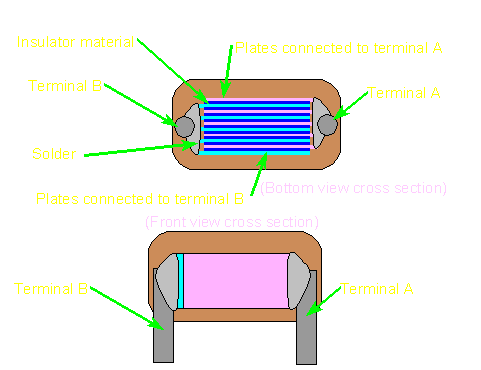
- Electrolytic Capacitors:
- Electrolytic caps are more
complex than film capacitors and are generally
used for larger capacitance values (0.47
microfarad and higher). The electrolytic
capacitor generally consists of 2 layers of
aluminum foil with a layer of paper material
between the plates. It looks a little like this:
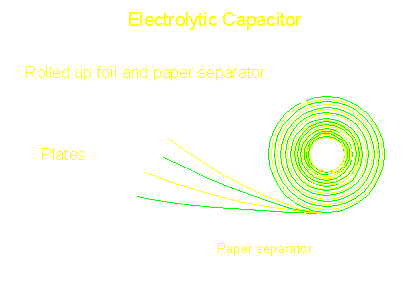
- Electrolytic Capacitor Foil:
- The aluminum foil that makes up
the plates in the electrolytic capacitor is
treated in a few different processes to make it
work properly and more efficiently. The most
important process is the anodizing of the foil.
Anodizing is a process that forms a very thin
layer of aluminum oxide on one or both sides of
the foil when the foil is immersed in an acidic
solution and direct current is applied to the
foil (one lead of the DC power supply is
connected to the foil and the other is connected
to a conductive plate in the acidic solution).
This layer of aluminum oxide is the dielectric
(insulator) and serves to block the flow of
direct current. To increase the surface area on
the foil (and ultimately increase capacitance),
the foil can be etched by a chemical process.
This would be done before the anodizing.
- Paper Element and Electrolyte:
- The paper element serves to
hold the electrolyte in place. The electrolytic
solution (generally ethylene glycol and
ammonium-borate) can vary in content but must
generally serve a couple of purposes. First and
foremost, it must be electrically conductive to
help pass the electrons from one plate to the
other (the glycol part of the solution does
this). Secondly it helps to heal any areas of the
dielectric that become damaged (the
ammonium-borate does this). If the conductive
properties of the electrolyte were absent, the
capacitor's value would be drastically reduced.
If the healing properties were absent and the
anodized coating was scratched or otherwise
damaged, the capacitor would leak DC from plate
to plate. The healing properties greatly
increases the useful life of the capacitor.
- Reverse Voltage:
- Electrolytic capacitors
generally have a positive and a negative
terminal. As we said earlier, the plates (foil)
of the capacitor are anodized with a DC current.
This anodizing process sets up the polarity of
the plate material (it deteremines which side of
the plate is positive and which is negative). We
also said that part of the electrolyte was to
help heal a damaged plate. Since it has the
properties to heal a damaged plate, it has the
ability to reanodize the plate. Since anodizing
process can be reversed, the electrolyte has the
ability to remove the oxide coating from the
foil. This would happen if the capacitor was
connected with reverse polarity. Since the
electrolyte can conduct electricity, if the
aluminum oxide layer is removed, the capacitor
would readily pass direct current from one plate
to the other (it would basically be a short
circuit from one plate to the other). This would,
of course, render the cap useless.
- Over Voltage:
- All capacitors have a voltage
rating. This tells you how much voltage the
dielectric (insulator) can withstand before
allowing DC to pass between its plates. Sometimes
a capacitor has a working voltage (i.e. WVDC
working voltage DC) and a surge voltage. The
working voltage tells you how much voltage the
capacitor can withstand long term (for the normal
life of the capacitor). The surge voltage is the
voltage is can withstand for short periods of
time. Generally, if too much voltage is applied
to a capacitor, it will fail. In electrolytic
capacitors, the forming voltage (voltage used to
anodize the plates) and the thickness of the
paper element determine the working voltage of
the cap. In film type capacitors, the insulating
material (polyethylene, polypropylene...) will
determine the maximum working voltage.
- 16 Volt Capacitors vs. 20 Volt
Capacitors:
- As you've likely noticed, large
1 farad (and 1/2 farad) capacitors are available
in both 16v and 20v versions. As was said above,
the voltage rating tells you how much voltage the
capacitor can withstand. It does NOT tell you how
much voltage it will have when connected to your
system. If both a 16v and a 20v capacitor are
conected to the electrical system (with a voltage
of 14.4 volts), both the 16v capacitor AND the
20v capacitor will have exactly 14.4 volts. The
voltage on the capacitor will be the same as the
circuit to which it's connected. In this
situation, both the 16v and the 20v capacitors
(which have identical capacitance ratings) will
hold precisely the same amount of energy. If (IF)
the capacitors were charged to their maximum
working voltage, the 20v capacitor would hold
more energy because it can survive higher
voltage. As you can see in the diagram below, all
of the electrical components have the same level
of water in them (they have the same voltage). If
you continue this analogy, you'll be able to
imagine that the lower voltage capacitor would
'overflow' if the voltage would go too high
(above 16 volts). The 20 volt capacitor could
accept a higher water level (voltage) before it
overflows. You can also see that when the
capacitors are fully filled, the 20 volt
capacitor can hold more water (energy). But... in
this situation (and in a car), they hold the same
amount of energy.
- As a side note... The volume of
water that a cylinder can hold is equal to the
surface area of the cross section of the cylinder
(which is analogous to the surface area of the
capacitor's plates) multiplied by the height of
the cylinder (which is analogous to the voltage
that the capacitor's dielectric (insulator) can
withstand). Increasing the surface area and/or
height of the cylinder (the maximum voltage
rating) will increase the maximum volume (charge)
the cylinder can hold.
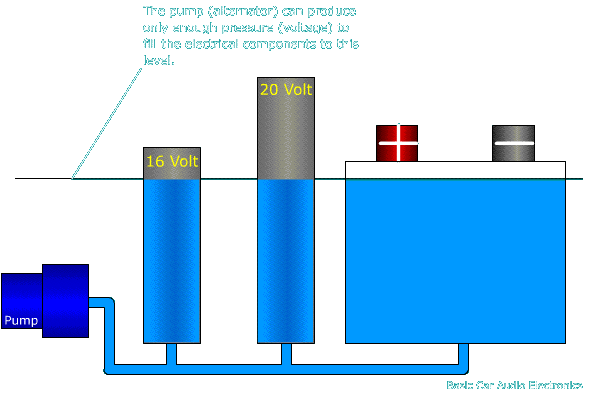
- Overheating and Venting:
- An electrolytic capacitor will
generally overheat if subjected to adverse
conditions such as overvoltage or reverse
polarity. This will cause the electrolyte to boil
off which will create pressure in the sealed
aluminum can that envelopes its internal
components. If there were no form of controlled
venting, the capacitor would eventually explode.
For safety's sake, capacitor manufacturers employ
some sort of pressure relief that will fracture
before the capacitor's aluminum enclosure. On
smaller capacitors, the vent are simply a few
stamped lines in the top of the capacitor. The
stamping weakens the aluminum casing slightly and
allows venting when the capacitor's internal
pressure reaches dangerous levels. The other type
of vent (used on very large capacitors) is a plug
that will blow when pressure reaches dangerous
levels.
- Stiffening Type Capacitors:
- A stiffening capacitor is
connected to the amplifier much the same way a
battery is. This means that the capacitor's
positive terminal is connected to the amplifier's
positive terminal (which also means that it's
connected to the battery's positive terminal).
The same is true of the capacitor's negative
terminal (the cap's negative terminal is
connected to chassis ground with the amplifier's
negative ground terminal). Like this...
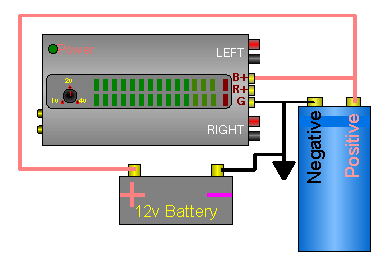
- Stiffening capacitors are used
as a sort of electrical shock absorber. As
voltage starts to rise, the capacitor will absorb
energy which will tend to keep the voltage from
rising as quickly as it otherwise would. If the
voltage starts to fall, the capacitor's stored
energy will flow out of the capacitor to try to
keep the voltage up. A capacitor's ability to
absorb/release energy from/to external circuits
depends on the capacitor's specs (capacitance,
ESR, ESL...), the output impedance of the power
source (alternator and power wire in this case)
and the circuit's input impedance (into the
amplifier's power supply).
- Power Source with NO Capacitor:
- In the following diagram, you
can see that the output voltage (red jagged line)
of the power supply is not very steady (with
respect to the white reference line). This
variation may be due to some defect in the power
supply or from varying current draw from other
devices that might be connected to the power
supply. You can see that the capacitor is NOT
connected to the power supply.
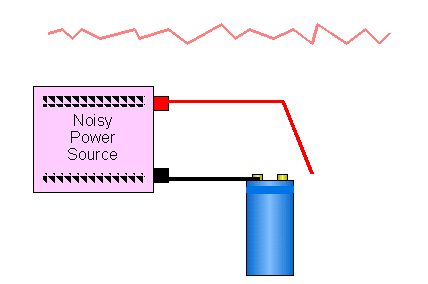
- Power Source with Capacitor:
- In the next diagram, you can
see that the capacitor is connected to the power
supply and the voltage is much more stable
(smaller ripples). The actual amount of smoothing
would depend on a lot of things like the source's
output impedance, the resistance in the wire and
the current draw from other devices.
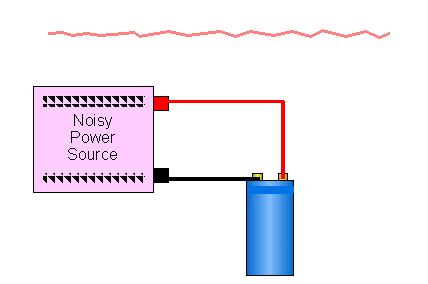
- Power Source with Series
Resistance:
- The following diagram shows how
series resistance (not ESR) allows the capacitor
to smooth the voltage even more. The series
resistance will allow the cap to smooth the
voltage but would cause a voltage drop if current
is drawn from the capacitor. Some low current
power supplies may be designed in this way to
provide a very smooth output voltage. This will
generally only work well if the current draw is
constant and known when designing the power
supply.
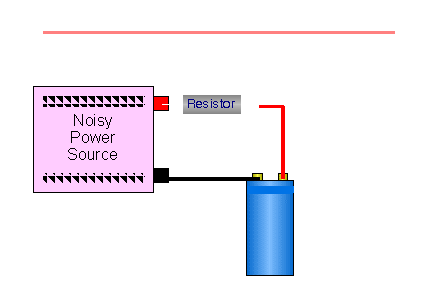
- Stiffening Caps and Car
Amplifiers:
- The following diagram shows how
the voltage could drop if the alternator's
regulator couldn't react quickly enough to
prevent a voltage drop. You should notice that
the capacitor is not
connected. The white line is the alternator's
regulated voltage (approximately 13.8 volts). The
dips are where the current draw is high. The
deeper dips are points where the current draw is
even higher.

- The diagram below shows what a
stiffening capacitor is supposed_to_do for a car
audio system. You can see how the ripple is
reduced now that the capacitor is connected. The
dips in voltage are smaller. If the capacitor
does its job, the added voltage (less voltage
drop means higher voltage available to the
amplifier) would give you more power output,
especially with amps with unregulated power
supplies. You probably noticed that I said
'supposed_to_do' earlier. This is because there
has been some discussion as to whether a
capacitor is a help or a hinderence when it comes
to keeping the voltage at a higher level than
without it. Of course, if you ask someone that's
spent more than $100 on a capacitor if it helped,
they'll tell you that it has. Why on earth would
someone 'fess up' to wasting that much money on
'snake oil'. I've yet to see a capacitor increase
the SPL in any system.
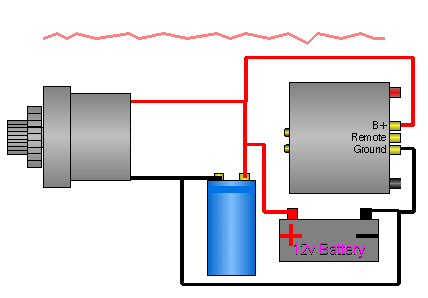
- NOTE:
- For maximum benefit, you should
keep the length of wire between the capacitor and
the amplifier to a minimum. Anything (wire,
distribution blocks, fuses...) between the
capacitor and the amplifier will reduce the
capacitor's ability to quickly supply the current
needed by the amplifier. Of course, if you have
multiple amplifiers and want the capacitor to
benefit all of them, you'll have to connect it to
the distribution block.
TECH TIP:
- Charging large capacitors:
- When connecting a large
capacitor (1/2 farad or larger) to the 12 volt
source, you may want to charge it slowly before
making the final connection to the power wire.
Most capacitors come with a resistor to charge
the cap slowly. If you're working on your system,
and disconnect the capacitor, the cap may get
discharged (something might accidentally touch
across the terminals or it may partially self
discharge over time). If you can't find the
original resistor to recharge the cap, you can
recharge it with a standard test light (you know,
the one with a light bulb, not one of those fancy
pants test lights with LED indicators). There's a
somewhat helpful demo near the bottom of the
page.
- If you don't have a test light
and want to use a resistor to charge or discharge
your capacitor, use a ceramic encapsulated high
power resistor like the one below (I'd recommend
using a resistor rated for 10 watts or more and
about 20 ohms). If you use a small resistor (i.e.
a 1/4 or 1/2 watt) of too low value (less than
100 ohms), it may get hot enough to seriously
burn your fingers.
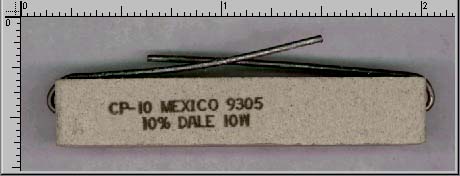
Ruler values are in inches.
- REASON:
- The reason you may want to
charge a cap slowly is to reduce the arcing
involved with fast charging. This arcing won't
hurt the cap but it might damage the chrome or
gold finish on the connectors.
- This demo shows how the test
light brightness indicates the charge level in
the capacitor. Put your cursor over each
capacitor charge status and watch the brightness
of the test light. If you have a slow connection,
it may take a second or two for each image to
load. Click on the amplifier below and the
image's position will be optimized.
- Discharging the Capacitor:
- If you're going to remove your
capacitor for some reason, you may want to
completely discharge the capacitor to prevent
creating a hazardous situation. To discharge the
capacitor (after it's disconnected from the
system), simply provide a path for the current to
flow from one terminal to the other. You can use
either the test light or the resistor. After it
is discharged, you may want to connect the
terminals together with a piece of wire or
resistor. Some large capacitors will act like a
battery and develop some small voltage across its
terminals. Since the capacitor is likely a large
capacitor (over 1/2 farad), the small voltage
could be dangerous. Even if your capacitor's
design doesn't cause it to develop a significant
voltage when not in use, leaving the terminals
connected will leave no doubt whether the cap is
charged or not.
- Charging with a Resistor:
- If you need to know how long it
will take to charge a capacitor with a given
resistor, you can use the following calculator.
The output data tells you how long 'one time
constant' is (time to reach 63.2% of the
difference in voltage between the capacitor's
voltage and the supply voltage). It also tells
you how much time it will take the capacitor to
become charged. Lastly, it tells you the maximum
power dissipation across the resistor (use this
value as a guide in selecting a resistor).
|